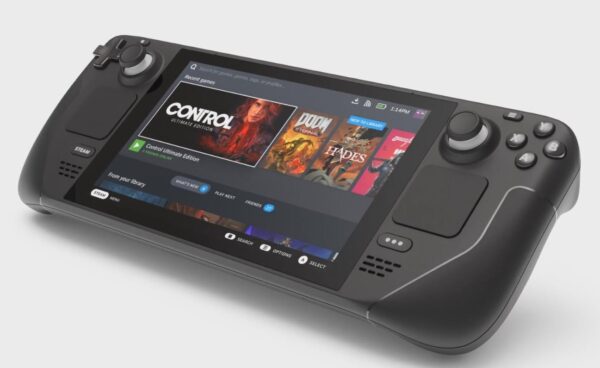
Valve has announced the Handheld PC they are calling the Steam Deck, which is a Switch-like device that is capable of playing Steam games on the go. It features a 7-inch touchscreen, two thumbsticks, a D-pad, and a four-button layout., in addition to trackpads for increased precision. There are eight triggers on its back are well, and is set for release in December 2021 for $399.
The Steam Deck will play games from gamers’ existing Steam libraries and you will simply need to log into your account. The Steam Deck is capable of running PC games on its own and does not need the cloud, and like the Switch, will come with a dock.
The Steam Deck boasts an APU built by AMD. Its CPU is based on the company’s Zen 2 microarchitecture and tops out at 3.5 GHz. The GPU contains eight RDNA 2 compute units at up to 1.6 GHz, delivering peak performance of 1.6 teraflops. The system packs 16 GB of RAM and a microSD card slot, allowing users to expand upon the built-in storage. The Steam Deck’s 7-inch screen is an LCD with a 16:10 aspect ratio at an HD resolution of 1280×800 and a 60 Hz refresh rate. The Steam Deck also features a dual-band 802.11ac Wi-Fi radio — it’s compatible with 2.4 GHz and 5 GHz networks — and Bluetooth 5.0 for controllers, accessories, and (unlike the Switch) audio. (source Polygon)
The Steam Deck will be available in three models with different storage options, but there are no performance differences between the three versions aside from the speed of the flash memory.
The $399 base model offers 64 GB of storage in the eMMC format. The next model up costs $529, and packs faster storage courtesy of a 256 GB PCIe 3.0 NVMe SSD; it also comes with an “exclusive Steam Community profile bundle.” The top-tier Steam Deck, at $649, includes a 512 GB NVMe SSD that Valve refers to as “high-speed,” although it is still a PCIe 3.0 drive. In addition, this model’s screen features “premium anti-glare etched glass.” The unit comes with an exclusive carrying case and exclusive virtual keyboard theme, on top of the cheaper models’ bonuses. (source Polygon)

